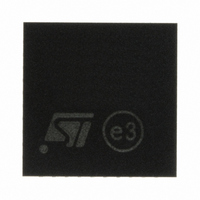SN260Q STMicroelectronics, SN260Q Datasheet - Page 35

SN260Q
Manufacturer Part Number
SN260Q
Description
IC ZIGBEE/802.15.4 PROC 40-QFN
Manufacturer
STMicroelectronics
Datasheet
1.SN260Q.pdf
(47 pages)
Specifications of SN260Q
Frequency
2.4GHz
Modulation Or Protocol
802.15.4
Applications
ZigBee™
Power - Output
-32dBm ~ 5dBm
Sensitivity
-97.5dBm
Voltage - Supply
2.1 V ~ 3.6 V
Current - Receiving
35.5mA
Current - Transmitting
35.5mA
Data Interface
PCB, Surface Mount
Antenna Connector
PCB, Surface Mount
Operating Temperature
-40°C ~ 85°C
Package / Case
40-QFN
For Use With
497-6404 - BOARD EVAL SPZB260 MOD FOR STR9497-5990 - KIT EVAL REVA FOR ZIGBEE497-5879 - NETWORK DEVELOPMENT FOR SN260497-5877 - KIT RADIO CARRIER FOR SN260
Lead Free Status / RoHS Status
Lead free / RoHS Compliant
Memory Size
-
Data Rate - Maximum
-
SN260
8
UART Gateway Protocol
The UART Gateway protocol is designed for network gateway systems in which the host
processor is running a full-scale operating system such as embedded Linux or Windows.
The host sends EmberZNet Serial Protocol (EZSP) commands to the UART interface using
Ember’s Asynchronous Serial Host (ASH) protocol. The EZSP commands are the same as
those used in the SPI protocol, but the SPI protocol is better suited for resource-constrained
microcontroller hosts since ASH uses considerably more host RAM and program storage.
ASH implements error detection/recovery and tolerates latencies on multi-tasking hosts due
to scheduling and I/O buffering. The ASH protocol is described in detail in the UART
Gateway Protocol Reference, 120-3010-000.
Ember supplies ASH host software in source form compatible with Linux and Windows. In
most cases it will need only a few simple edits to adapt it to a particular host system.
Figure 13. UART interface signals
The UART hardware interface uses the following SN260 signals:
●
●
●
Serial data: TXD and RXD
The ASH protocol sends data in both directions, so both TXD and RXD signals are
required. An external pull-up resistor should be connected to TXD to avoid data glitches
while the SN260 is resetting.
Flow control: nRTS and nCTS (optional)
ASH uses hardware handshaking for flow control: nRTS enables transmission from the
host to the SN260, and nCTS enables SN260 transmissions to the host. If the host
serial port cannot support RTS/CTS, XON/XOFF flow control may be used instead.
But, XON/XOFF will deliver slightly lower performance.
When using hardware flow control, the SN260’s nRTS must be able to control host
serial output. However, in many gateway systems, the host will not need to throttle
transmission by the SN260. In those systems nCTS may be left unconnected since it
has an internal pull-down and will be continuously asserted.
Reset control: nRESET
The host must be able to reset the SN260 to run the ASH protocol. The best way to do
this is to use a host output connected to nRESET. If this is not feasible, the host can
send a special ASH frame that requests the SN260 to reboot, but this method is less
reliable than asserting nRESET and is not recommended for normal use.
UART Gateway Protocol
35/47












